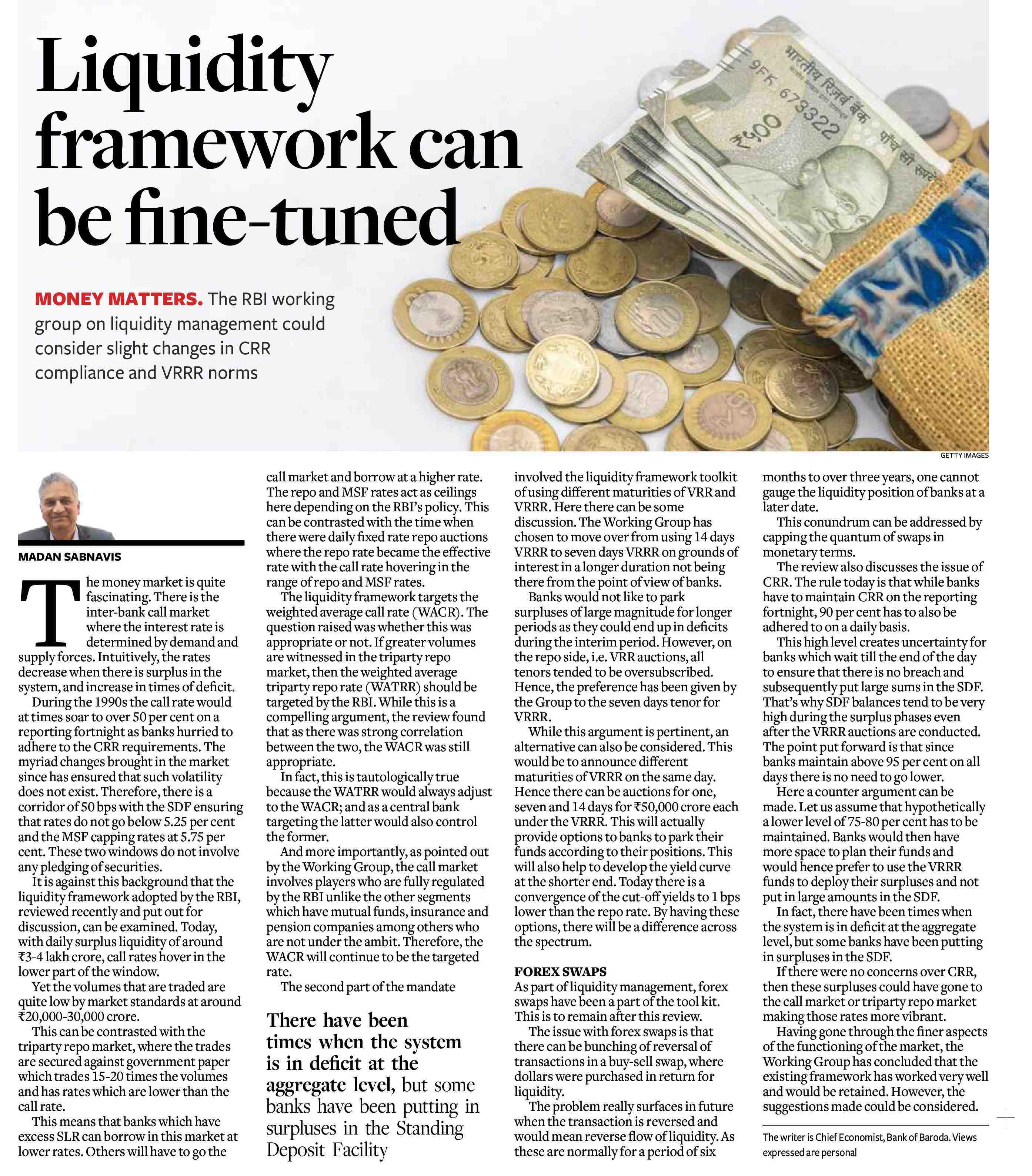Liquidity framework can be fine-tuned
Liquidity framework can be fine-tuned
MONEY MATTERS. The RBI working
group on liquidity management could
consider slight changes in CRR
compliance and VRRR norms
he money market is quite
fascinating. There is the
inter-bank call market
where the interest rate is
determined by demand and
supply forces. Intuitively, the rates
decrease when there is surplus in the
system, and increase in times of deficit.
During the 1990s the call rate would
at times soar to over 50 per cent on a
reporting fortnight as banks hurried to
adhere to the CRR requirements. The
myriad changes brought in the market
since has ensured that such volatility
does not exist. Therefore, there is a
corridor of 50 bps with the SDF ensuring
that rates do not go below 5.25 per cent
and the MSF capping rates at 5.75 per
cent. These two windows do not involve
any pledging of securities.
It is against this background that the
liquidity framework adopted by the RBI,
reviewed recently and put out for
discussion, can be examined. Today,
with daily surplus liquidity of around
*3-4 lakh crore, call rates hover in the
lower part of the window.
Yet the volumes that are traded are
quite low by market standards at around
20,000-30,000 crore.
This can be contrasted with the
triparty repo market, where the trades
are secured against government paper
which trades 15-20 times the volumes
and has rates which are lower than the
call rate.
This means that banks which have
excess SLR can borrow in this market at
lower rates. Others will have to go the
call market and borrow at a higher rate.
The repo and MSF rates act as ceilings
here depending on the RBI's policy. This
can be contrasted with the time when
there were daily fixed rate repo auctions
where the repo rate became the effective
rate with the call rate hovering in the
range of repo and MSF rates.
The liquidity framework targets the
weighted average call rate (WACR). The
question raised was whether this was
appropriate or not. If greater volumes
are witnessed in the triparty repo
market, then the weighted average
triparty repo rate (WATRR) should be
targeted by the RBI. While this is a
compelling argument, the review found
that as there was strong correlation
between the two, the WACR was still
appropriate.
In fact, this is tautologically true
because the WATRR would always adjust
to the WACR; and as a central bank
targeting the latter would also control
the former.
And more importantly, as pointed out
by the Working Group, the call market
involves players who are fully regulated
by the RBI unlike the other segments
which have mutual funds, insurance and
pension companies among others who
are not under the ambit. Therefore, the
WACR will continue to be the targeted
rate.
The second part of the mandate
There have been
times when the system
is in deficit at the
aggregate level, but some
banks have been putting in
surpluses in the Standing
Deposit Facility
involved the liquidity framework toolkit
of using different maturities of VRR and
VRRR. Here there can be some
discussion. The Working Group has
chosen to move over from using 14 days
VRRR to seven days VRRR on grounds of
interest in a longer duration not being
there from the point of view of banks.
Banks would not like to park
surpluses of large magnitude for longer
periods as they could end up in deficits
during the interim period. However, on
the repo side, i.e. VRR auctions, all
tenors tended to be oversubscribed.
Hence, the preference has been given by subsequently put large sums in the SDF.
the Group to the seven days tenor for
VRRR.
While this argument is pertinent, an
alternative can also be considered. This
would be to announce different
maturities of VRRR on the same day.
Hence there can be auctions for one,
seven and 14 days for ₹50,000 crore each
under the VRRR. This will actually
provide options to banks to park their
funds according to their positions. This
will also help to develop the yield curve
at the shorter end. Today there is a
convergence of the cut-off yields to 1 bps
lower than the repo rate. By having these
options, there will be a difference across
the spectrum.
FOREX SWAPS
As part of liquidity management, forex
swaps have been a part of the tool kit.
This is to remain after this review.
The issue with forex swaps is that
there can be bunching of reversal of
transactions in a buy-sell swap, where
dollars were purchased in return for
liquidity.
The problem really surfaces in future
when the transaction is reversed and
would mean reverse flow of liquidity. As
these are normally for a period of six
months to over three years, one cannot
gauge the liquidity position of banks at a
later date.
This conundrum can be addressed by
capping the quantum of swaps in
monetary terms.
The review also discusses the issue of
CRR. The rule today is that while banks
have to maintain CRR on the reporting
fortnight, 90 per cent has to also be
adhered to on a daily basis.
This high level creates uncertainty for
banks which wait till the end of the day
to ensure that there is no breach and
That's why SDF balances tend to be very
high during the surplus phases even
after the VRRR auctions are conducted.
The point put forward is that since
banks maintain above 95 per cent on all
days there is no need to go lower.
Here a counter argument can be
made. Let us assume that hypothetically
a lower level of 75-80 per cent has to be
maintained. Banks would then have
more space to plan their funds and
would hence prefer to use the VRRR
funds to deploy their surpluses and not
put in large amounts in the SDF.
In fact, there have been times when
the system is in deficit at the aggregate
level, but some banks have been putting
in surpluses in the SDF.
If there were no concerns over CRR,
then these surpluses could have gone to
the call market or triparty repo market
making those rates more vibrant.
Having gone through the finer aspects
of the functioning of the market, the
Working Group has concluded that the
existing framework has worked very well
and would be retained. However, the
suggestions made could be considered.
The writer is Chief Economist, Bank of Baroda. Views
expressed are personal

